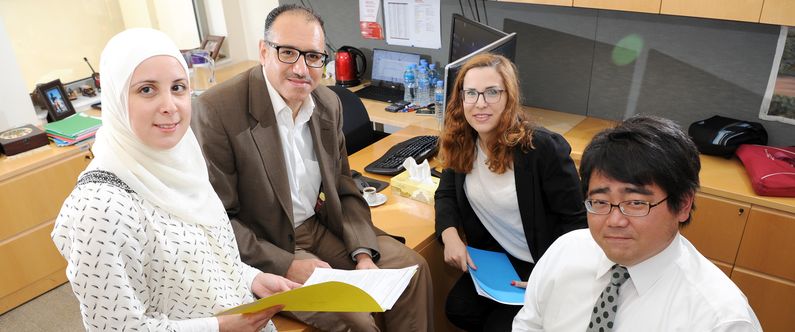Herpes type 1 virus is emerging as a main cause of genital disease in Asia
 Professor Laith Abu-Raddad, second from left, and his team.
Professor Laith Abu-Raddad, second from left, and his team.
Researchers at Weill Cornell Medicine-Qatar (WCM-Q) found that transmission patterns of herpes simplex virus type 1 (HSV-1) are changing in Asia in a striking way, and that this virus is emerging as a key sexually transmitted infection. According to findings published today in the high impact and prestigious Journal of Clinical Infectious Diseases, 20 percent of genital herpes cases and six percent of genital ulcer cases are now caused by HSV-1.
HSV-1 is one of the most widespread infections globally. It is normally transmitted orally leading to blisters and lesions around the mouth known as oral herpes. Recent data from the United States and Western Europe, however, showed that HSV-1 can also be transmitted sexually leading to genital herpes and genital ulcer disease. The data also indicated that the rate of genital infection is increasing in Western countries. Nonetheless, it was unknown whether this newly emerging trend is happening in other parts of the world.
However, the study, conducted by the Infectious Disease Epidemiology Group (IDEG) at WCM-Q, demonstrated that this is also the case in Asia. The study found that although HSV-1 remains mostly orally transmitted, the virus is increasingly being transmitted sexually. The study, which provided a comprehensive characterization of HSV-1 infection patterns in Asian countries, also estimated that about 50 percent of children are infected with the virus, all of whom are infected orally, and that 75 percent of adults are infected with the virus, through both the oral and genital routes.
“It was striking for us to discover this shift in HSV-1 transmission patterns from oral to genital infection in Asia,” said Manale Harfouche, joint first author of the study and senior research specialist at WCM-Q.
Lara Khadr, joint first author and research intern at WCM-Q added: “This is an intriguing transition for an infection known historically only as an oral infection. It remains to be seen whether this transition is also happening in other parts of the world.”
Laith Abu-Raddad, principal investigator of the study and professor of healthcare policy and research at WCM-Q, concluded: “These findings demonstrate the criticality of accelerating HSV-1 vaccine development to control transmission and to prevent the medical and psychosocial disease burden that is emerging from this infection.”
The study, entitled ‘The epidemiology of herpes simplex virus type 1 in Asia: systematic review, meta-analyses, and meta-regressions’, was conducted with funding from the Qatar National Research Fund through the National Priorities Research Program (NPRP 9-040-3-008).
Key scientific findings of the study
• HSV-1 is playing an influential role as a sexually transmitted infection in Asia.
• 20 percent of genital herpes cases and six percent of genital ulcer disease cases are caused by HSV-1.
• 50 percent of children and 75 percent of adults are infected with HSV-1.